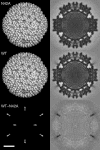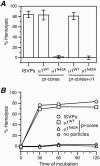Putative autocleavage of outer capsid protein micro1, allowing release of myristoylated peptide micro1N during particle uncoating, is critical for cell entry by reovirus
- PMID: 15280481
- PMCID: PMC479062
- DOI: 10.1128/JVI.78.16.8732-8745.2004
Putative autocleavage of outer capsid protein micro1, allowing release of myristoylated peptide micro1N during particle uncoating, is critical for cell entry by reovirus
Abstract
Several nonenveloped animal viruses possess an autolytic capsid protein that is cleaved as a maturation step during assembly to yield infectious virions. The 76-kDa major outer capsid protein micro1 of mammalian orthoreoviruses (reoviruses) is also thought to be autocatalytically cleaved, yielding the virion-associated fragments micro1N (4 kDa; myristoylated) and micro1C (72 kDa). In this study, we found that micro1 cleavage to yield micro1N and micro1C was not required for outer capsid assembly but contributed greatly to the infectivity of the assembled particles. Recoated particles containing mutant, cleavage-defective micro1 (asparagine --> alanine substitution at amino acid 42) were competent for attachment; processing by exogenous proteases; structural changes in the outer capsid, including micro1 conformational change and sigma1 release; and transcriptase activation but failed to mediate membrane permeabilization either in vitro (no hemolysis) or in vivo (no coentry of the ribonucleotoxin alpha-sarcin). In addition, after these particles were allowed to enter cells, the delta region of micro1 continued to colocalize with viral core proteins in punctate structures, indicating that both elements remained bound together in particles and/or trapped within the same subcellular compartments, consistent with a defect in membrane penetration. If membrane penetration activity was supplied in trans by a coinfecting genome-deficient particle, the recoated particles with cleavage-defective micro1 displayed much higher levels of infectivity. These findings led us to propose a new uncoating intermediate, at which particles are trapped in the absence of micro1N/micro1C cleavage. We additionally showed that this cleavage allowed the myristoylated, N-terminal micro1N fragment to be released from reovirus particles during entry-related uncoating, analogous to the myristoylated, N-terminal VP4 fragment of picornavirus capsid proteins. The results thus suggest that hydrophobic peptide release following capsid protein autocleavage is part of a general mechanism of membrane penetration shared by several diverse nonenveloped animal viruses.
Figures







Similar articles
-
Requirements for the formation of membrane pores by the reovirus myristoylated micro1N peptide.J Virol. 2009 Jul;83(14):7004-14. doi: 10.1128/JVI.00377-09. Epub 2009 May 13. J Virol. 2009. PMID: 19439475 Free PMC article.
-
Putative autocleavage of reovirus mu1 protein in concert with outer-capsid disassembly and activation for membrane permeabilization.J Mol Biol. 2005 Jan 21;345(3):461-74. doi: 10.1016/j.jmb.2004.10.026. J Mol Biol. 2005. PMID: 15581891
-
Strategy for nonenveloped virus entry: a hydrophobic conformer of the reovirus membrane penetration protein micro 1 mediates membrane disruption.J Virol. 2002 Oct;76(19):9920-33. doi: 10.1128/jvi.76.19.9920-9933.2002. J Virol. 2002. PMID: 12208969 Free PMC article.
-
Attachment and cell entry of mammalian orthoreovirus.Curr Top Microbiol Immunol. 2006;309:1-38. doi: 10.1007/3-540-30773-7_1. Curr Top Microbiol Immunol. 2006. PMID: 16909895 Review.
-
Control of Capsid Transformations during Reovirus Entry.Viruses. 2021 Jan 21;13(2):153. doi: 10.3390/v13020153. Viruses. 2021. PMID: 33494426 Free PMC article. Review.
Cited by
-
Interferon-inducible transmembrane protein 3 (IFITM3) restricts reovirus cell entry.J Biol Chem. 2013 Jun 14;288(24):17261-71. doi: 10.1074/jbc.M112.438515. Epub 2013 May 6. J Biol Chem. 2013. PMID: 23649619 Free PMC article.
-
Viroporins customize host cells for efficient viral propagation.DNA Cell Biol. 2013 Oct;32(10):557-64. doi: 10.1089/dna.2013.2159. Epub 2013 Aug 14. DNA Cell Biol. 2013. PMID: 23945006 Free PMC article. Review.
-
A proapoptotic peptide derived from reovirus outer capsid protein {micro}1 has membrane-destabilizing activity.J Virol. 2011 Feb;85(4):1507-16. doi: 10.1128/JVI.01876-10. Epub 2010 Nov 24. J Virol. 2011. PMID: 21106751 Free PMC article.
-
Infectious Subviral Particle-induced Hemolysis Assay for Mammalian Orthoreovirus.Bio Protoc. 2018 Jan 20;8(2):e2701. doi: 10.21769/BioProtoc.2701. Bio Protoc. 2018. PMID: 29552594 Free PMC article.
-
Mechanisms of reovirus-induced cell death and tissue injury: role of apoptosis and virus-induced perturbation of host-cell signaling and transcription factor activation.Viral Immunol. 2005;18(1):89-115. doi: 10.1089/vim.2005.18.89. Viral Immunol. 2005. PMID: 15802955 Free PMC article. Review.
References
-
- Attoui, H., Q. Fang, F. M. Jaafar, J. F. Cantaloube, P. Biagini, P. De Micco, and X. De Lamballerie. 2002. Common evolutionary origin of aquareoviruses and orthoreoviruses revealed by genome characterization of Golden shiner reovirus, Grass carp reovirus, Striped bass reovirus and golden ide reovirus (genus Aquareovirus, family Reoviridae). J. Gen. Virol. 83:1941-1951. - PubMed
-
- Baker, T. S., and R. H. Cheng. 1996. A model-based approach for determining orientations of biological macromolecules imaged by cryo-electron microscopy. J. Struct. Biol. 116:120-130. - PubMed
-
- Barton, E. S., J. C. Forrest, J. L. Connolly, J. D. Chappell, Y. Liu, F. J. Schnell, A. Nusrat, C. A. Parkos, and T. S. Dermody. 2001. Junction adhesion molecule is a receptor for reovirus. Cell 104:441-451. - PubMed
Publication types
MeSH terms
Substances
Grants and funding
LinkOut - more resources
Full Text Sources
Other Literature Sources

